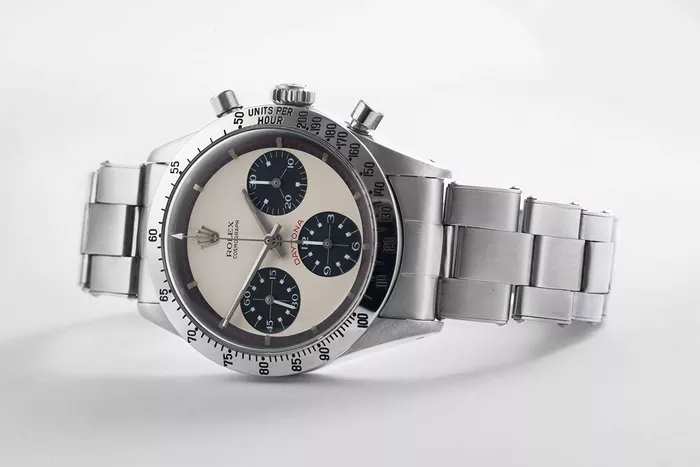In the realm of luxury watches, few timepieces are as iconic and revered as the Rolex Daytona ‘Paul Newman.’ This ultimate guide takes you on a journey through the history, design intricacies, notable features, and the unparalleled legacy that surrounds this legendary watch.
I. The Origins: Paul Newman and Rolex Daytona
1. Introduction to Paul Newman
Paul Newman, the legendary actor and race car driver, played a pivotal role in the Rolex Daytona’s rise to fame. His association with the watch began when his wife gifted him a Rolex Daytona during the filming of the racing film “Winning.”
Newman’s preference for the Daytona, both on and off the screen, led to its colloquial naming as the “Paul Newman” Daytona.
2. Evolution of Rolex Daytona
The Rolex Daytona itself has a storied history, initially designed for professional racing drivers. The ‘Paul Newman’ variation, introduced in the 1960s, features distinctive design elements that set it apart, including an exotic dial and contrasting sub-dials.
II. Distinctive Design Elements: The Paul Newman Dial
1. Exotic Dial Characteristics
The ‘Paul Newman’ dial is instantly recognizable for its unique design. The Art Deco-style font for the numerals, the square-tipped registers, and the crosshairs on the sub-dials contribute to its distinct aesthetic.
The contrasting color combination, often with a colored outer track, adds a layer of vibrancy to the dial, making it a standout feature.
2. Artistry in Detailing
The meticulous attention to detail in the dial is evident. The sub-dials, with their blocky markers and distinctive shapes, create a visual balance that is both functional and aesthetically pleasing.
Each element of the dial reflects Rolex’s commitment to precision and craftsmanship, contributing to the enduring appeal of the ‘Paul Newman’ Daytona.
III. Mechanical Excellence: The Rolex Movement
1. In-House Caliber
Powering the ‘Paul Newman’ Daytona is Rolex’s in-house caliber, emphasizing the brand’s commitment to horological excellence. The movement is a self-winding chronograph, known for its reliability and accuracy.
The use of an in-house movement adds a layer of exclusivity to the ‘Paul Newman’ Daytona, showcasing Rolex’s expertise in the art of watchmaking.
2. Chronograph Functionality
The chronograph function is a key feature of the Daytona, allowing precise measurement of elapsed time. The screw-down pushers ensure water resistance while the smooth operation of the chronograph reflects the watch’s superior engineering.
Rolex’s dedication to creating a high-performance timekeeping instrument is evident in the seamless integration of the chronograph function.
IV. Materials and Craftsmanship: Rolex Quality
1. Stainless Steel Construction
The ‘Paul Newman’ Daytona is often found in stainless steel, a material prized for its durability and timeless appeal. The case and bracelet are meticulously finished, with polished and brushed surfaces adding depth to the design.
Rolex’s use of high-quality materials reflects its commitment to creating watches that not only exude luxury but can withstand the rigors of everyday wear.
2. Oyster Case and Water Resistance
The ‘Paul Newman’ Daytona features Rolex’s Oyster case, known for its robustness and hermetically sealed design. This construction provides water resistance, a crucial element for a watch designed for professional racing.
The watch’s ability to withstand water adds to its versatility, making it a timepiece suitable for both the race track and daily life.
V. Investment Value and Rarity: Paul Newman’s Legacy
1. Rarity and Collectibility
The ‘Paul Newman’ Daytona, especially those with the exotic dial, is considered rare and highly collectible. The limited production numbers during the 1960s and 1970s contribute to its scarcity.
Collectors are drawn to the ‘Paul Newman’ Daytona not only for its aesthetic appeal but also for its historical significance and the association with Paul Newman himself.
2. Investment Value
Over the years, the ‘Paul Newman’ Daytona has become a coveted collector’s item, with auction prices reaching staggering heights. The watch’s investment value is a testament to its enduring popularity and the demand among enthusiasts.
Owning a ‘Paul Newman’ Daytona is not just a symbol of refined taste but also a wise investment in horological history.
VI. FAQs – Unveiling More About the Rolex Daytona ‘Paul Newman’
Q1: Why is the Rolex Daytona with the exotic dial called the ‘Paul Newman’ Daytona?
A1: The association with Paul Newman comes from the actor’s preference for the Rolex Daytona. His wife gifted him a Daytona during the filming of “Winning,” and his frequent wearing of the watch led to its colloquial naming as the ‘Paul Newman’ Daytona.
Q2: What makes the ‘Paul Newman’ dial distinctive?
A2: The ‘Paul Newman’ dial is distinctive for its Art Deco-style numerals, square-tipped sub-dials, and contrasting colors. The exotic dial’s unique design, including the blocky markers and crosshairs, sets it apart from other Daytona variations.
Q3: Why is the ‘Paul Newman’ Daytona considered a collectible item?
A3: The ‘Paul Newman’ Daytona is considered collectible due to its rarity and historical significance. Produced in limited numbers during the 1960s and 1970s, the watch has become a sought-after item among collectors, contributing to its high market value.
Q4: What is the investment value of the Rolex Daytona ‘Paul Newman’?
A4: The ‘Paul Newman’ Daytona has significant investment value, with auction prices reaching remarkable heights. Its desirability among collectors and enthusiasts, coupled with its limited production numbers, has turned it into a wise investment in the world of luxury watches.

